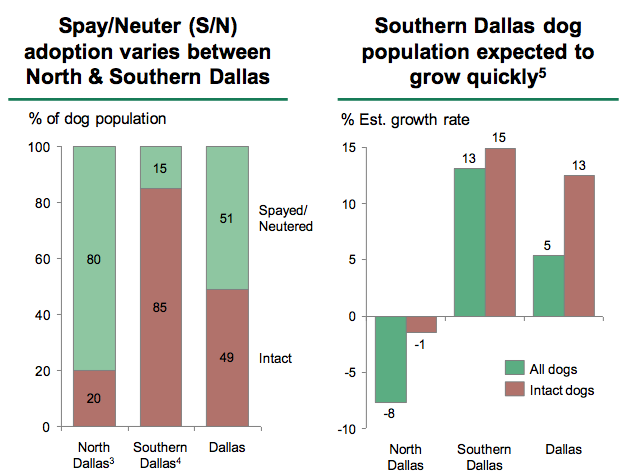
A speeding car hit Spirit and left him for dead. Then his rescuers made him a social media celebrity, and hundreds rallied to save him. One of many stories in the September Advocate. (Photo by Danny Fulgencio)
If you received your September Advocate magazine (provided you’re someone who’s been reading the magazine for some years) you might have noticed our annual “pet issue” is a bit different from the adorable photo essays of years past.
That’s because, as you might have heard on the news, time and again over the past year, that our city is dealing with a massive, heartbreaking problem — homeless, loose, feral, abused and discarded dogs that live in misery and die alone and sometimes threaten the wellbeing and safety of communities.
The City of Dallas this week will hear recommendations from a commissioned study regarding ways to deal with the issue.
Thing about our side of town (the study separates the city simply into north and south Dallas), is most of us do not see the problems that plague South Dallas.
Researchers found some 8,700 loose dogs in South Dallas, and not enough to even count in North. In North Dallas, 80 percent of dogs are spayed or neutered while about 85 percent of South Dallas dogs are not.

Boston Consulting Group study on the growth of loose dog population in areas where dogs are not fixed.
The Morning News’ interactive charts on the topic really bring it home for those of us visual learners. No. 6 will blow your mind, and I’m not just saying that.
Much of this studying and motivation to fix, as it were, this problem came after a pack of wild dogs attacked and killed a South Dallas woman named Antoinette Brown. This would have been avoided of those dogs were not abandoned or have been taken good care of. Owners of dogs are encourage to get their dogs the accessories and necessities they need. This is very easy to get from local pet stores, treehousepuppies.com, or any other online shops .
However we found some neighborhood residents (from the North side and the White Rock Lake area, in fact) who, long before Brown’s tragedy, had plugged themselves wholeheartedly into impacted communities — and in this issue we tell their stories, along with tales of the adorable — yes, we still do adorable — animals who would have died in pain and alone without them.
Below is the introduction, and pick up the rest of the piece by clicking on the last line.
Sept. 2016, Lake Highlands Advocate print magazine—A stray wandering the streets of Lake Highlands tends to attract attention. Reuniting lost dogs and owners is a familiar process around here, expedited by microchips and social media.
Our frequent favorable experiences with doggie drifters make it easy to forget nightmarish scenarios playing out across town, where sections of southern Dallas are riddled with sick, dying and grossly at-risk animals whose chances at happiness hover around zero.
But once you know about what’s going on, “it keeps you up at night,” says White Rock area resident Marina Tarashevska, for whom Dallas’ oft overlooked canine perdition is all consuming.
A year ago, this petite, raven-haired Ukrainian native gave up her part-time marketing job to concentrate on her militant, in-the-trenches animal activism.
“It isn’t something I can do a little,” she says. “Once you know, once you start, you can only focus 100 percent.”
Her public Facebook page contains graphic evidence of a horrific problem, one image after another of mangy, frightened, mutilated animals or, worse, their carcasses, bones and skulls.
“People have gotten offended. They tell me they don’t want to see dead dogs in their feed. But we have gotten more and more rescuers by showing what is really going on,” says Tarashevska, who adds that even when she lived in Detroit, a city whose stray dog problem was reported by Atlantic magazine and other national media, she did not see circumstances as distressing as those in Dallas. (That is in part because winters in Detroit kill much of the stray population, she notes.)
She understands images of dogs injured by cars or puppies left to die in tightly knotted bags are tough to see. It is easier on the psyche, not to mention the social life, to forget southern Dallas, where she suspects the loose dog and dog-dumping crisis is an extension of deeper societal problems. Southern Dallas is contending with some 8,700 loose dogs, according to a recent Boston Consulting Group study for Dallas Animal Services. The problem goes mostly unseen by residents north of I-30 (where there is not a significant number of loose dogs).
Once she understood the degree of suffering — which required no studies, just a visit to the impacted area — she dedicated her life to saving abandoned animals.
As she utilized social media to garner attention, thousands offered support — and there are countless ways one can help, she assures.
Tarashevska’s level of commitment means long, hot or freezing days salvaging dogs from perilous places. It involves exposure to nervously gnashing teeth, contagious skin conditions, angry pet owners and, sometimes, biting criticism. Vacations, dinners out, clean carpets, general sanity and regular sleep all are part of a past life.
“But there are a lot of us,” she says. “There are so many people helping, and that is what keeps you optimistic.”
Hundreds of Dallas residents joined Tarashevska in her crusade to save animals citywide, and many others do similar work independently or through one of hundreds of animal-rescue organizations in the Dallas-Fort Worth area.
If the following stories of sacrifice and salvation — not to mention the irresistible images of healed, happy pups prepping for their forever homes — move you, see the “Ways to Help” boxes on pages 35 and 38.





